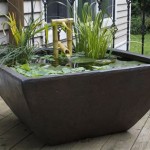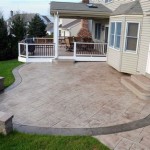Best Way to Clean Dirty Concrete Patio Slabs
Concrete patios, while durable and versatile outdoor spaces, are susceptible to becoming dirty and stained over time. Exposure to the elements, spills, and general foot traffic contribute to the accumulation of dirt, grime, mildew, algae, and various unsightly marks. Regular cleaning is essential to maintain the patio's appearance, prevent long-term damage, and ensure a safe and enjoyable outdoor environment. The following details effective methods and considerations for successfully cleaning dirty concrete patio slabs.
Assessing the Patio's Condition and Determining the Cleaning Approach
Before commencing any cleaning process, it is crucial to thoroughly assess the existing condition of the concrete patio. This involves identifying the types of stains present, the extent of the dirt accumulation, and any underlying issues such as cracks or structural damage. Knowing the specific challenges will help determine the most suitable cleaning method and the necessary tools and cleaning solutions.
Common types of stains found on concrete patios include organic stains from leaves, grass, and berries; oil and grease stains from grilling or vehicle leaks; rust stains from metal furniture; mildew and algae growth in damp, shaded areas; and general dirt and grime buildup. The severity of these stains will influence the choice of cleaning agents and the intensity of the cleaning effort required.
Furthermore, it is necessary to consider the age and condition of the concrete itself. Older concrete may be more porous and susceptible to damage from harsh chemicals or high-pressure washing. Identifying any existing cracks or weaknesses is crucial to avoid exacerbating these problems during the cleaning process. Applying a sealant after cleaning can help protect the concrete and prevent future staining.
Based on the assessment, one can select the appropriate cleaning method. Options range from simple sweeping and rinsing to more intensive scrubbing with specialized cleaners and pressure washing. The goal is to choose the most effective method while minimizing the risk of damage to the concrete surface.
Effective Cleaning Methods for Concrete Patio Slabs
Various methods can be employed to clean dirty concrete patio slabs, each with its own advantages and disadvantages. The choice of method depends on the severity of the dirt and stains, the condition of the concrete, and the desired level of cleanliness. The following outlines several commonly used and effective cleaning methods.
1. Sweeping and Rinsing: For lightly soiled patios, a simple combination of sweeping and rinsing can often be sufficient. This involves using a stiff-bristled broom to remove loose dirt, leaves, and debris from the surface. Following the sweeping, the patio can be rinsed with a garden hose to wash away any remaining surface dirt. This method is environmentally friendly and requires minimal effort, but it is not effective for removing stubborn stains or deeply ingrained dirt.
2. Soap and Water Scrubbing: For patios with more significant dirt accumulation, scrubbing with soap and water can be an effective solution. This involves mixing a mild detergent, such as dish soap or laundry detergent, with water and applying the solution to the concrete surface. A stiff-bristled brush is then used to scrub the patio thoroughly, paying particular attention to stained or heavily soiled areas. After scrubbing, the patio should be rinsed thoroughly with clean water to remove all traces of soap. This method is generally safe for most concrete surfaces, but it may not be effective for removing oil or grease stains.
3. Using a Pressure Washer: A pressure washer can be a powerful tool for cleaning dirty concrete patios. The high-pressure water spray can effectively blast away dirt, grime, mildew, and algae. However, it is crucial to use caution when using a pressure washer, as excessive pressure can damage the concrete surface. It is advisable to start with a low-pressure setting and gradually increase it as needed, while maintaining a safe distance between the nozzle and the concrete. A wide-angle nozzle is preferable to a narrow-angle nozzle to avoid concentrating the pressure on a small area. After pressure washing, it is important to allow the patio to dry completely.
4. Specialized Concrete Cleaners: For stubborn stains or heavily soiled patios, specialized concrete cleaners may be necessary. These cleaners are formulated to break down specific types of stains, such as oil, grease, rust, or mildew. When using a specialized cleaner, it is imperative to follow the manufacturer's instructions carefully, paying attention to dilution ratios, application methods, and safety precautions. Some concrete cleaners may contain harsh chemicals that can damage the concrete or harm the environment, so it is important to choose a product that is appropriate for the specific type of stain and the condition of the concrete. Before applying the cleaner to the entire patio, it is recommended to test it on a small, inconspicuous area to ensure that it does not cause any discoloration or damage.
5. Vinegar and Baking Soda: A mixture of vinegar and baking soda can be an effective and natural cleaning solution for concrete patios. This combination creates a bubbling reaction that helps to lift dirt and grime from the surface. To use this method, sprinkle baking soda over the patio and then pour white vinegar over the baking soda. Allow the mixture to bubble and fizz for several minutes, then scrub the patio with a stiff-bristled brush. Rinse thoroughly with clean water. This method is particularly effective for removing mildew and algae, and it is a safe and environmentally friendly alternative to harsh chemicals.
6. Oxygen Bleach: Oxygen bleach, also known as sodium percarbonate, is a gentler alternative to chlorine bleach for cleaning concrete patios. It is effective for removing organic stains, such as those caused by leaves, grass, or berries. To use oxygen bleach, mix it with warm water according to the manufacturer's instructions and apply the solution to the patio. Allow it to sit for several hours or overnight, then scrub the patio with a stiff-bristled brush and rinse thoroughly with clean water. Oxygen bleach is biodegradable and does not release harmful fumes, making it a safer option for both the environment and the user.
Preventative Measures to Keep Concrete Patio Slabs Clean
In addition to regular cleaning, implementing preventative measures can help maintain the cleanliness of concrete patio slabs and reduce the frequency of intensive cleaning efforts. These measures focus on minimizing the accumulation of dirt, stains, and mildew, as well as protecting the concrete surface from damage.
1. Regular Sweeping: Regularly sweeping the patio with a stiff-bristled broom can prevent the buildup of dirt, leaves, and debris. This simple task should be performed at least once a week, or more frequently in areas with heavy foot traffic or exposure to the elements. Removing loose debris prevents it from becoming ground into the concrete surface and reduces the risk of staining.
2. Quick Spill Cleanup: Promptly cleaning up spills is crucial to prevent staining. Whether it is a spilled drink, food, or oil, wiping it up immediately can prevent it from penetrating the concrete and leaving a permanent mark. Use absorbent cloths or paper towels to soak up the spill, and then clean the area with soap and water.
3. Using Patio Furniture Covers: Patio furniture can contribute to dirt and stains on concrete patios. Covering furniture when it is not in use can protect it from dust, pollen, and bird droppings, which can then be transferred to the concrete surface. Furniture covers also protect the furniture itself from the elements, extending its lifespan.
4. Applying a Concrete Sealer: Applying a concrete sealer can provide a protective barrier against stains, moisture, and damage. A sealer penetrates the concrete pores and makes it more resistant to dirt, oil, and other contaminants. There are various types of concrete sealers available, including penetrating sealers and topical sealers. Penetrating sealers absorb into the concrete and provide long-lasting protection, while topical sealers form a protective layer on the surface. The choice of sealer depends on the desired level of protection and the appearance of the concrete. It is important to follow the manufacturer's instructions carefully when applying a concrete sealer.
5. Proper Drainage: Ensuring proper drainage can prevent water from pooling on the patio, which can lead to mildew and algae growth. If the patio is sloped incorrectly or if there are drainage issues, it may be necessary to regrade the area or install a drainage system. Keeping the patio dry will also help prevent cracking and deterioration of the concrete.
6. Using Mats and Rugs: Placing mats and rugs in high-traffic areas can help protect the concrete from wear and tear and reduce the amount of dirt that is tracked onto the patio. Choose mats and rugs that are designed for outdoor use and that are easy to clean. Shake them out regularly to remove dirt and debris.
By implementing these preventative measures, one can significantly reduce the amount of cleaning required and maintain the appearance of the concrete patio for years to come.

How To Clean Patio Slabs Minster Paving

How To Clean Patio Slabs Make Your Sparkle For Spring With Three Household Items Express Co

How To Clean Paving Patios A Comprehensive Guide Awbs

How To Clean Paving Slabs With Bleach Water Directory

How To Clean Patio Slabs Kärcher International

3 Ways To Clean A Stone Patio Wikihow

Best Tips On Cleaning Patio Slabs How To Get Rid Of Algae

Best Way To Clean A Concrete Patio Chalking Up Success

How To Clean Paving Slabs With Bleach Water Directory

How To Clean Patios Avoid Vinegar Cleaning S Or Risk Corrosion Best Use Express Co
Related Posts








